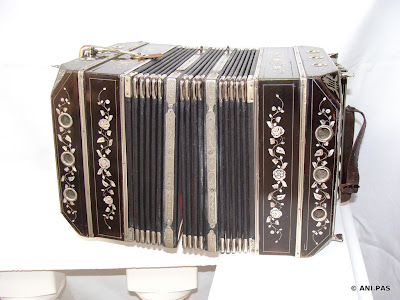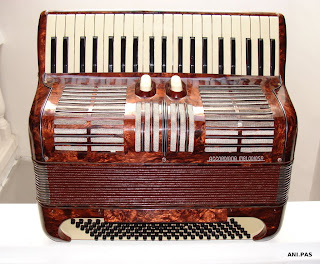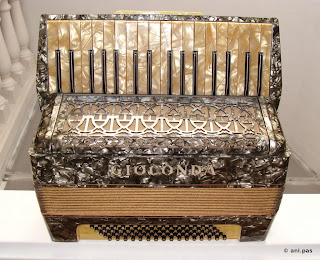Type: Keyboard Piano Accordion-tailed, a very rare model,
color: red, but it also did in color white, ca. 1940.
The accordion has 37 keys, a register of door lever and 3 chests reeds, soprano in the chorus means 3. The bass has 80 buttons and contains 4 songs.
Training ergonomic keyboard caudata an accordion was invented for the primera time for the engineer Silvio Scandalli, bed & Ancona, Italy, in the year 1929.
The factory was already established to Paolo Soprani In the year 1863 in Castelfidardo / Italy. He was also primero Italian manufacturer of accordions.
His workmanship was merged with that of other Scandalli in the year 1987. From 1988 to 1995, both manufacturers signed, under the name of "The Accordion", but in this merger were part of the company "Farfisa" - short for truck manufacturers Riunite SpA Italian accordion, Castelfidardo, which was founded in 1946 for a year. Silvio Scandalli / bedroom, 2. (Paul) Septimus Soprani / Castelfidardo and 3. Alfredo Screen Numana. In the year 1987, Grupo Bontempi took possession of "Farfisa". "The Accordion" sign under the continuaró viejo name. Separated in 1995 and assumed the name of FARFISA "MENGHINI. In 2003, the company was merged with manufacturing MENGHINI "SEM", Recanati, who was co-founded in 1973 by Ubaldo Gabbanelli years. Beginning of this time, the manufactories firmaron under the name "Sound", Castelfidardo.
Accordion: Paolo Soprani - Founder of the Italian Accordion Industry
Type: Piano accordion with curved keyboard, a really rare model,
colour: red, it was also produced in white colour, approx. 1940.
The accordion disposes of 37 keys, one switch register and 3 reed blocks in the treble. The bass-side owns 80 bass buttons and 2 reed blocks, i. e. 4 choirs.
The ergonomic formation of a curved keyboard of an accordion was the first time invented by the engineer Silvio Scandalli, Camerano / Ancona, Italy, in the year 1929.
This factory was already founded by Paolo Soprani in the year 1863 in Castelfidardo / Italy. He also was the first Italian manufacturer of accordions.
His factory was merged with that of Scandalli in 1987. From 1988 to 1995, Both factories traded under the name "The Fisamonica", But They Were In That constellation Also part of the factory "Farfisa" - abbreviation of the Italian accordion truck manufacturers Riunite SpA, Castelfidardo. Was founded in 1946 by a Farfisa. Silvio Scandalli / bedroom, 2. Paolo Soprani Septimus / Castelfidardo and 3. Alfredo Screen Numana. In the year 1987 Took Possession of the group Bontempi Farfisa. "The Accordion" furthermore continued to trade under old name ITS, But in the year 1995 separated from FARFISA Gave Itself and the name "MENGHINI. In the year 2003, the factory MENGHINI Was merged with the factory "SEM" Recanati, Which Was co-founded in the year 1973 by Ubaldo Gabbanelli. Since then, These three factories under the company trade marking "Sounds", Castelfidardo.
Acordeon: Paolo Soprani - Fundador de la "de la Industria Italian Accordion" (of Acordeon)
Type: Floor Acordeon-teclado caudado with a modelo muy rare
color: red, but has also in white, approx. 1940.
The accordion has 37 keys, a record handle and 3 voices in the treble. The bass has 80 buttons and contains 4 voices.
Training caudate ergonomic keyboard of the accordion was invented for the first time by the engineer Silvio Scandalli, Camerano / Ancona, Italy, in 1929.
Manufacturing and was founded by Paolo Soprani in 1863 in Castelfidardo / Italy. He was also the first Italian manufacturer of accordions.
Its Manufacturing was merged with the other that of Scandalli in 1987. From 1988 to 1995 both signed articles under the name "The Fisarmonica" but in this constellation were part of the firm "FARFISA - abrevación of Fabricche Fisarmoniche Riunite Italiane SpA, Castelfidardo, which was founded in 1946 by 1. Silvio Scandalli / Camerano, 2. (Paolo) Settimio Soprani / Castelfidardo and 3. Alfredo di Frontalini Numana. In 1987 the Group took up FARFISA Bontempi, "The Fisarmonica" sign was still under its old name. Separated in 1995 of FARFISA and assumed the name "Menghini. In 2003, the firm was merged Menghini SEM with the manufacture, Recanati, who was co-founded in 1973 by Ubaldo Gabbanelli. Starting from this time, manufacturing sign merged under the name "Suoni" Castelfidardo.
Akkordeon: Paolo Soprani - Gründer der Akkordeon-Industrie italian
Typ: geschweifte Tastatur, seltene wirklich ein Modell,
, Farbe: rot, is weißer wurde auch in Farbe produced, about 1940th
The accordion has 37 keys, a tab switcher and 3 choirs in Diskantteil. The bass shows 80 buttons and includes 4 choral groups.
The ergonomic design of a keyboard on a piano accordion was invented for the first time in 1929 by the engineer Silvio Scandalli, Camerano / Ancona, Italy.
Paolo Soprani The company was founded in 1863 in Castelfidardo, Italy, and was the first Italian accordion manufacturers.
Paolo Soprani 1987 merged with the company Scandalli. In 1995 the business ran - from 1988 both under the name "La Fisarmonica" and were part of the company "FARFISA" Fabricche Fisarmoniche Riunite Italiane SpA, Castelfidardo, 1946 by the first Silvio Scandalli / Camerano, 2 (Paolo) Settimio Soprani / Castelfidardo and 3rd Founded Alfredo Frontalini Numana Tues. FARFISA was acquired in 1987 by the group Bontempi. "La Fisarmonica" changed its name still below its name. But in 1995 she separated from FARFISA and was named "MENGHINI. MENGHINI was founded in 2003 with the company "SEM", Recanati, the 1973 co-founded by Ubaldo Gabbanelli, fused to that date under the symbol to operate "Suoni" Castelfidardo.
© ANI.PAS



































